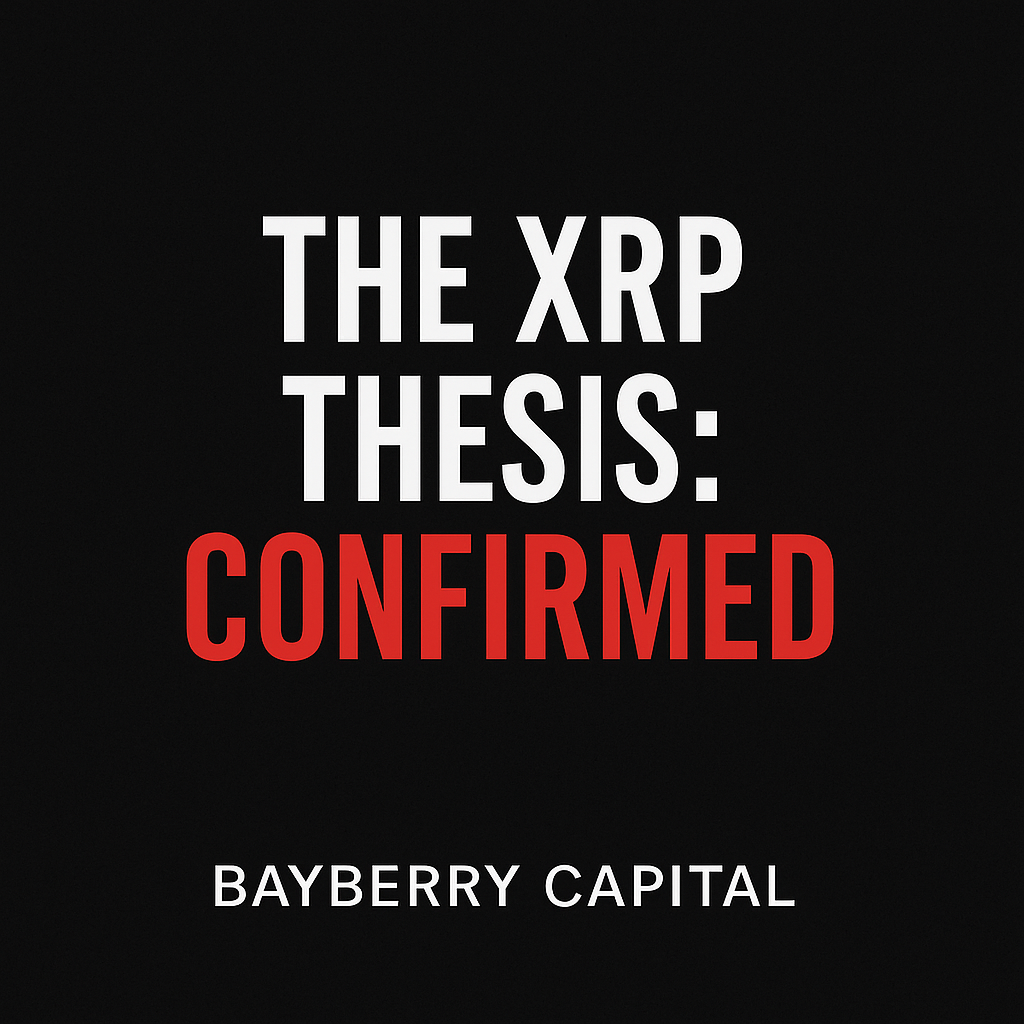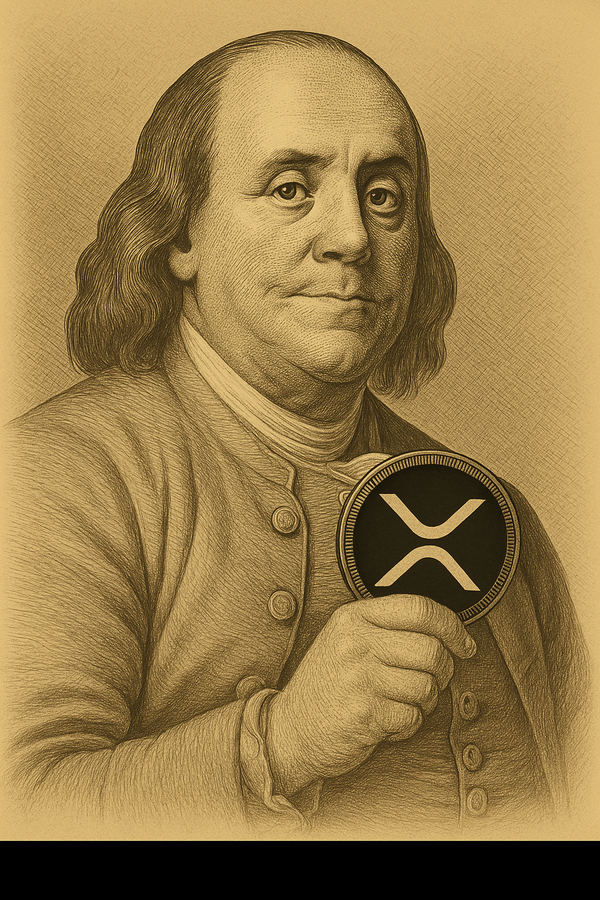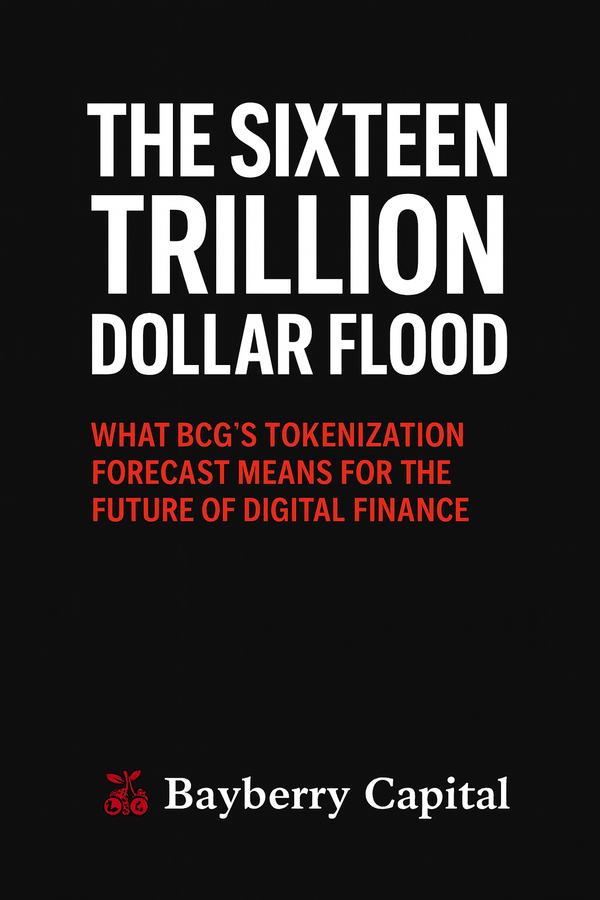The XRP Thesis: Confirmed

For years, XRP was the most misunderstood asset in the digital economy. It was mocked, dismissed, and buried under regulatory fog. But conviction isn’t built in the light. It’s forged in uncertainty. Those who understood the fundamentals knew what was being constructed beneath the noise: the foundation of the next financial system.
We weren’t chasing hype. We were front-running infrastructure.
And now, the thesis is being confirmed in real time.
The Long Game
Bayberry Capital’s stance on XRP has always been rooted in utility, not narrative. The market chased tokens with promises of innovation while XRP quietly became the bridge for value itself.
Most investors treated crypto like a casino. We studied the architecture. We understood that instant settlement, deep liquidity, and interoperability would reshape global finance. We recognized that regulation was a feature, not a threat, and that clarity would one day separate speculation from structure.
That separation is here.
The Infrastructure Is Live
Ripple’s long-term strategy was never about partnership headlines. It was about ownership. Piece by piece, they’ve built the full institutional stack.
Metaco brought institutional custody.
Standard Custody & Trust added U.S.-regulated asset storage for banks and funds.
GTreasury connected $13 trillion in corporate treasury management to on-chain settlement.
Rails provided payment and liquidity infrastructure for real-time flows.
Evernorth emerged as an XRP-focused treasury company, backed by Ripple, with more than $1 billion committed for open-market XRP accumulation.
This is a vertically integrated financial engine. Custody, treasury, liquidity, and settlement all exist within one ecosystem. The XRP Ledger now functions as institutional-grade financial infrastructure, quietly supporting the systems that move value across borders.
This isn’t an idea anymore. It’s operational reality.
The Regulatory Chapter Is Over
The case is closed.
A federal court defined XRP as not a security, giving it a clarity few assets in the space can claim. Ripple now operates freely with financial institutions, central banks, and payment providers.
That ruling redefined XRP’s risk profile overnight. It transitioned from uncertainty to legitimacy without a new product launch or marketing campaign. It simply survived, proved its use case, and outlasted everything else.
What remains is clarity. And in global finance, clarity is everything.
The Liquidity Engine of the New System
Cross-border payments were only the starting point. The larger purpose of XRP is to serve as the liquidity engine for the tokenized economy.
Ripple’s upcoming RLUSD stablecoin will function as the regulated counterweight to XRP’s bridge utility. Together, they create a two-asset system: XRP moves liquidity, RLUSD provides stability. This design enables institutional flows at scale, allowing banks, treasuries, and fintechs to source liquidity on demand and settle instantly across networks.
The XRPL is no longer a concept of interoperability. It’s the architecture that makes it real.
ETF Momentum and Market Recognition
Multiple XRP ETFs are now in development. This isn’t retail-driven excitement; it’s institutional preparation. ETFs represent the next phase of adoption, offering regulated vehicles for balance sheet exposure to XRP’s liquidity infrastructure.
These ETFs aren’t about speculation. They exist because the underlying ecosystem now meets institutional standards for custody, regulation, and price discovery. When they launch, they won’t mark the beginning of XRP’s story. They’ll confirm what professionals already know: the market is ready.
The Macro Layer
The global financial system is being rebuilt in front of us.
The Bank for International Settlements, Boston Consulting Group, and World Economic Forum all forecast the tokenization of more than $16 trillion in assets by 2030. The infrastructure required for that shift must be interoperable, efficient, and capable of real-time settlement.
That is exactly what the XRP Ledger was designed to do.
Tokenized treasuries, stablecoins, CBDCs, and real-world assets all need neutral bridges that can move value between systems. Ripple’s expanding ecosystem now provides that function, supported by regulatory clarity and enterprise-grade architecture.
The pieces are in place for institutional liquidity to move on-chain.
The Quiet Fulfillment
The thesis has matured.
Ripple built the stack. Regulation is settled. The infrastructure is live. Stablecoin issuance is near. ETFs are forming. Liquidity rails are being connected across markets.
Everything that once required faith is now visible.
At Bayberry Capital, XRP was never a speculative trade. It was a long-term bet on the infrastructure layer of a digitized financial world.
This is not the end of the story. It’s the beginning of its realization.
The thesis is confirmed. Now comes the flow of capital.





